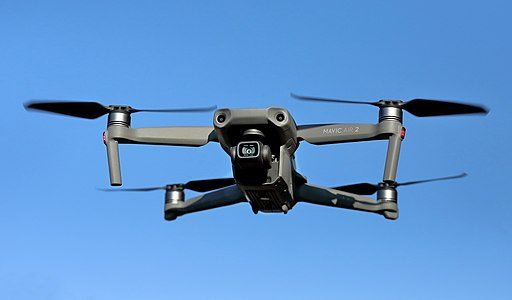At AUVSI’s Policy Symposium, officials outlined how BIS rulemaking could impact Chinese-manufactured drones and broader U.S. drone policy.
The AUVSI Drone and AAM Policy Symposium, held July 29–30 in Washington, D.C., brought government and industry leaders together to discuss the future of drone policy in the U.S.


In a featured fireside chat, Michael Robbins, President and CEO of AUVSI, sat down with Elizabeth Cannon, Executive Director of the Office of Information and Communications Technology and Services (OICTS) at the U.S. Department of Commerce. The session, titled What to Expect: How BIS Rulemaking Will Shape the Future of UAS Compliance, focused on how the U.S. government may use its authority to manage risks associated with foreign-manufactured drones—particularly those from China.
What is the OICTS?
The Office of Information and Communications Technology and Services (OICTS) is a division within the U.S. Department of Commerce, operating under the Bureau of Industry and Security (BIS). OICTS is responsible for identifying and addressing national security risks related to the use of foreign information and communications technologies, including drones, telecommunications equipment, and other digital infrastructure. The office plays a key role in evaluating and regulating transactions involving potentially sensitive technologies, particularly those involving countries of concern such as China or Russia. OICTS helps ensure that critical U.S. infrastructure remains secure from foreign exploitation or control.
Focused Authority Under the ICTS Rule
Cannon explained that the Secretary of Commerce has broad authority under the ICTS (Information and Communications Technology and Services) rule to prohibit or place conditions on transactions involving data transmission technologies when they pose a national security risk.
The rule is based on Executive Order 13873, signed in May 2019 during the first Trump administration, titled “Securing the Information and Communications Technology and Services Supply Chain.” It authorizes the Secretary of Commerce to take action against certain transactions involving ICTS from “foreign adversaries.”That authority allows the Department to respond to specific threats by either banning transactions or requiring safeguards.
A recent rulemaking focused on connected vehicles offer a useful example of how the agency operates, Cannon said. In that case, the Department identified two main risks: exploitation of personal data such as location or facial recognition, and the potential for remote control of the vehicle. A Notice of Proposed Rulemaking (NPRM) led to industry feedback, resulting in a final rule that was focused, phased, and informed by industry engagement.
Applying the Framework to Chinese Drones
Robbins asked how this same authority could be applied to drones, especially given the widespread presence of Chinese-made drones already in the U.S. market. Cannon acknowledged that drones were not included in the connected vehicles rule specifically because of those differences.
She noted that the consumer drone market’s direct-to-consumer sales model, combined with the $800 de minimis threshold, complicates enforcement. Imports under that threshold are not subject to the same reporting requirements as larger transactions, making tracking difficult.
To address these challenges, the Department is considering two key strategies:
-
Narrowing the scope of regulations to cover only specific technologies that pose real threats to national security
-
Using phased timelines to allow time for industry to adjust and for alternative suppliers to scale up
Cannon emphasized that these approaches aim to minimize disruption while addressing urgent national security concerns.
Identifying Risk: What Technologies Matter?
Instead of taking a blanket approach, Cannon said the agency is focused on identifying particular systems of concern—such as software with specific security vulnerabilities or communication components tied to foreign adversaries. In some cases, they may not need to restrict entire product lines, but only the most sensitive technologies within them.
This level of precision also helps avoid the “whack-a-mole” scenario, in which one banned entity simply shifts assets to another legal structure. Cannon said regulators are developing methods to detect such changes, including hardware analysis and software markers, to better identify when a product is controlled by a restricted party in the PRC or Russia.
Size Matters: Larger Drones May See Earlier Action
When asked whether the Department would prioritize different classes of drones, Cannon said that larger drones could be the first focus area. Larger systems are more likely to be tracked through formal channels, don’t fall under the de minimis exemption, and are often used in critical infrastructure sectors. However, she noted that security risks exist across the spectrum of drone sizes, including hobbyist models.
Executive Order and Coordination with Other Efforts
Cannon also discussed the impact of a recent Executive Order that set a 90-day deadline for issuing guidance. She said the OICTS is coordinating closely with other agencies—nine in total—through a formal interagency review process to ensure consistency.
Robbins highlighted that other efforts to restrict PRC-manufactured drones, such as the ongoing Section 232 investigation by the Department of Commerce, could overlap. Cannon agreed, stating that the ICTS rulemaking and Section 232 efforts are expected to be complementary.
She stressed the importance of collaboration, noting the existence of technology working groups and interagency coordination mechanisms that aim to ensure the federal government speaks with one voice.
What’s Next: Comment Period and Industry Engagement
When asked about the opportunity for public input, Cannon confirmed that the agency will allow additional public comment, even if it proceeds using the Interim Final Rule (IFR) process, which allows for earlier implementation. She reaffirmed the Department’s commitment to engaging with industry stakeholders to make the rules as effective and practical as possible.
Read more:


Miriam McNabb is the Editor-in-Chief of DRONELIFE and CEO of JobForDrones, a professional drone services marketplace, and a fascinated observer of the emerging drone industry and the regulatory environment for drones. Miriam has penned over 3,000 articles focused on the commercial drone space and is an international speaker and recognized figure in the industry. Miriam has a degree from the University of Chicago and over 20 years of experience in high tech sales and marketing for new technologies.
For drone industry consulting or writing, Email Miriam.
TWITTER:@spaldingbarker
Subscribe to DroneLife here.


